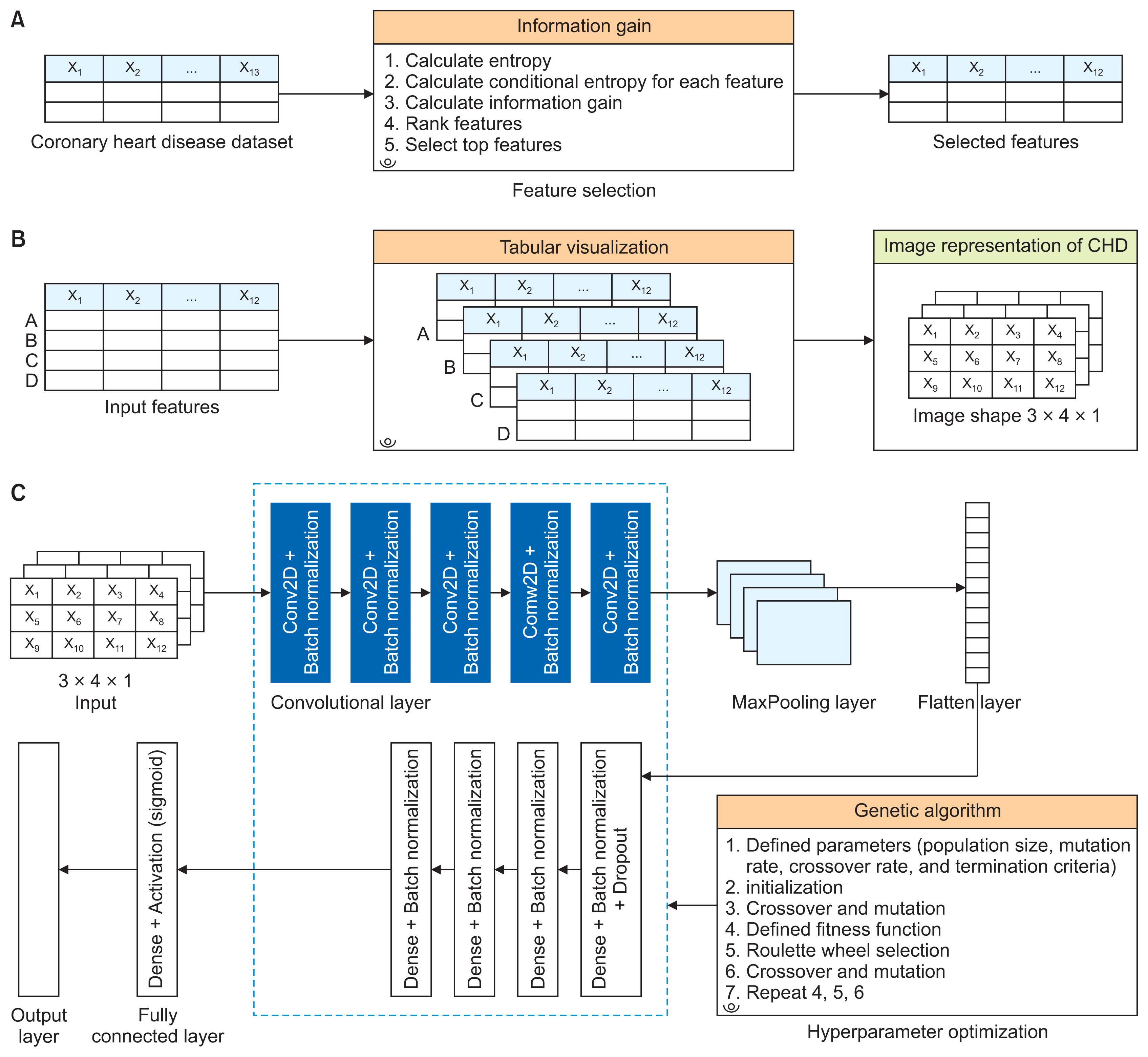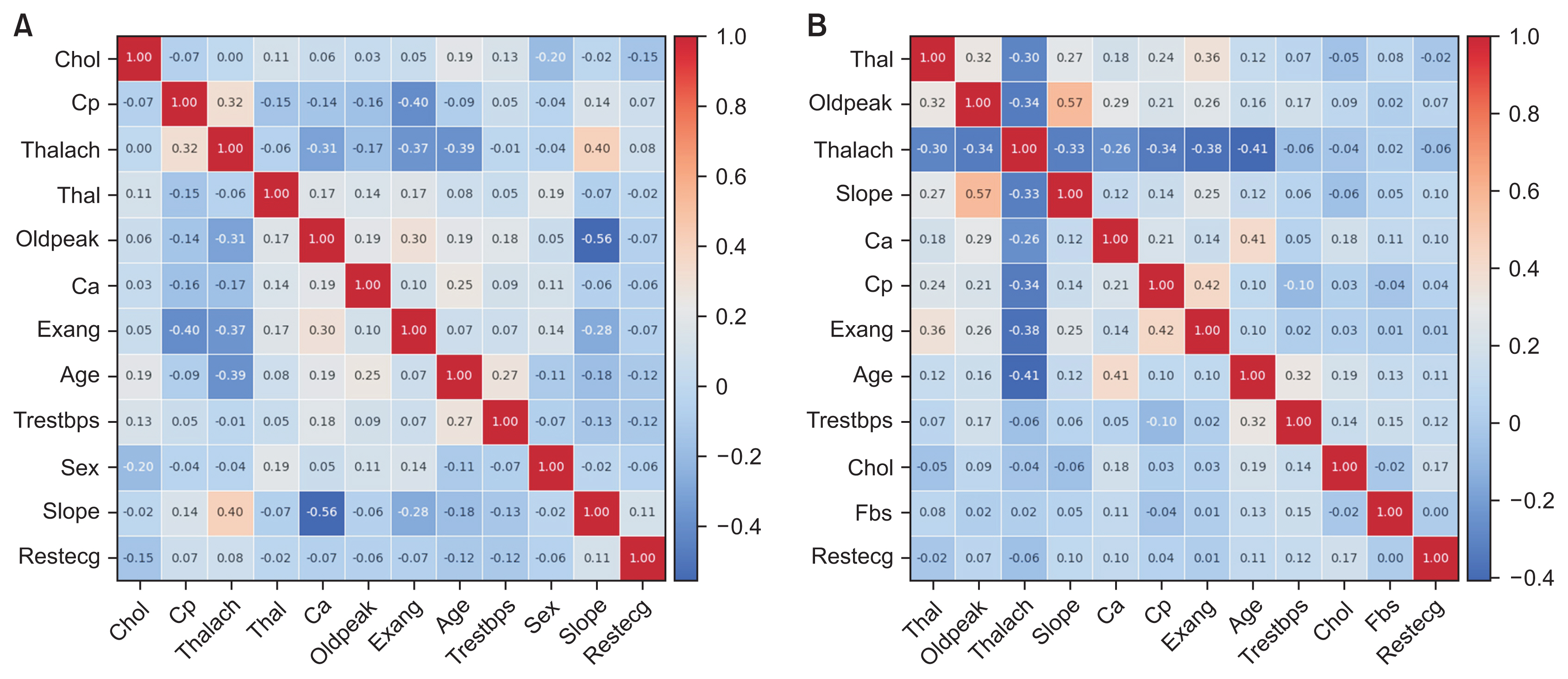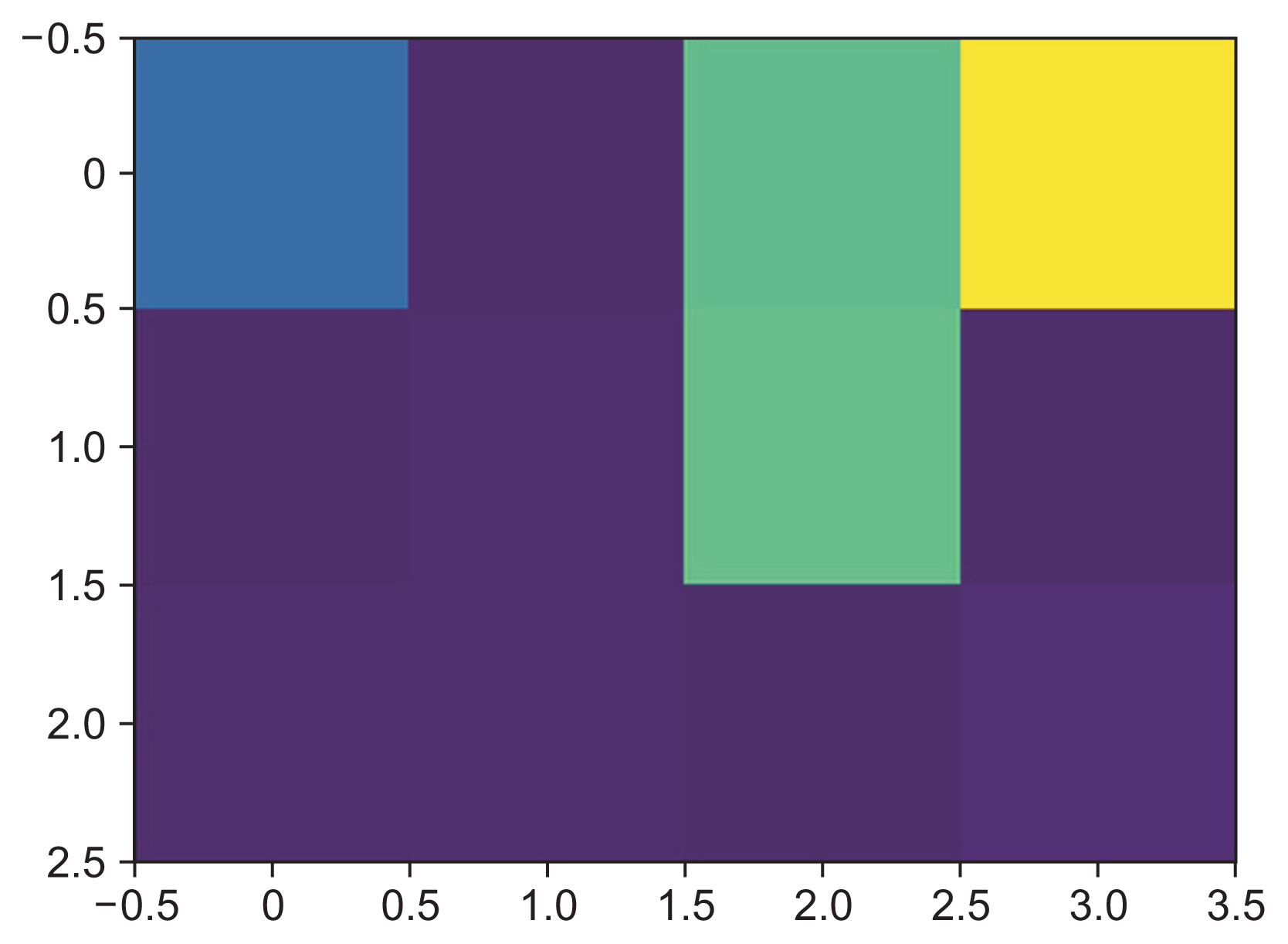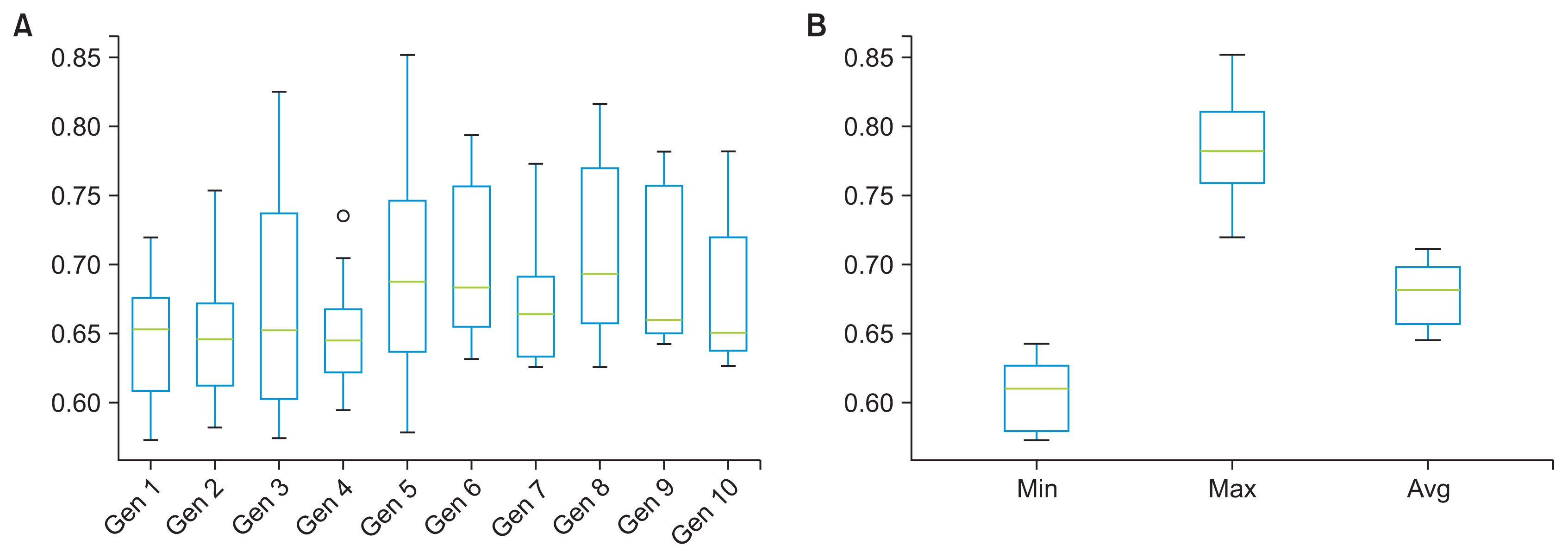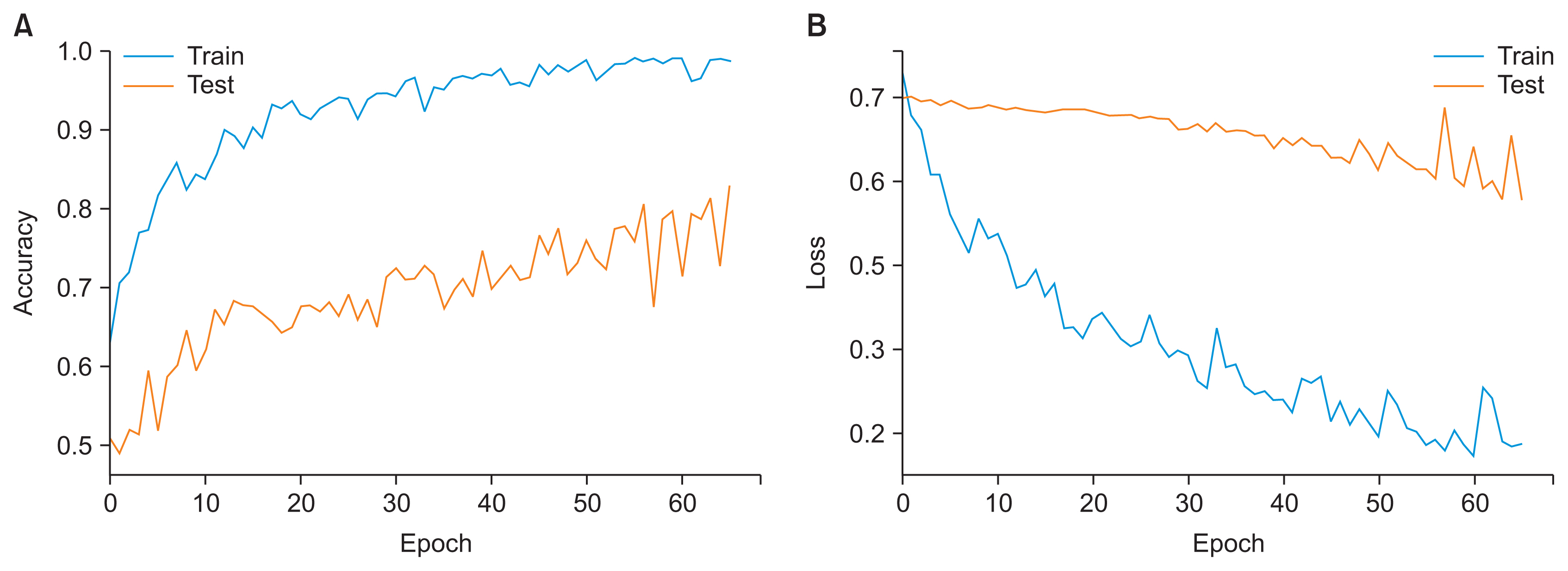Healthc Inform Res.
2024 Jul;30(3):234-243. 10.4258/hir.2024.30.3.234.
Genetic Algorithm-based Convolutional Neural Network Feature Engineering for Optimizing Coronary Heart Disease Prediction Performance
- Affiliations
-
- 1Faculty of Computer Science, Universitas Dian Nuswantoro, Semarang, Indonesia
- 2Research Center for Intelligent Distributed Surveillance and Security, Universitas Dian Nuswantoro, Semarang, Indonesia
- 3Technical College of Management Mosul, Northern Technical University, Mosul, Iraq
- KMID: 2558319
- DOI: http://doi.org/10.4258/hir.2024.30.3.234
Abstract
Objectives
This study aimed to optimize early coronary heart disease (CHD) prediction using a genetic algorithm (GA)-based convolutional neural network (CNN) feature engineering approach. We sought to overcome the limitations of traditional hyperparameter optimization techniques by leveraging a GA for superior predictive performance in CHD detection.
Methods
Utilizing a GA for hyperparameter optimization, we navigated a complex combinatorial space to identify optimal configurations for a CNN model. We also employed information gain for feature selection optimization, transforming the CHD datasets into an image-like input for the CNN architecture. The efficacy of this method was benchmarked against traditional optimization strategies.
Results
The advanced GA-based CNN model outperformed traditional methods, achieving a substantial increase in accuracy. The optimized model delivered a promising accuracy range, with a peak of 85% in hyperparameter optimization and 100% accuracy when integrated with machine learning algorithms, namely naïve Bayes, support vector machine, decision tree, logistic regression, and random forest, for both binary and multiclass CHD prediction tasks.
Conclusions
The integration of a GA into CNN feature engineering is a powerful technique for improving the accuracy of CHD predictions. This approach results in a high degree of predictive reliability and can significantly contribute to the field of AI-driven healthcare, with the possibility of clinical deployment for early CHD detection. Future work will focus on expanding the approach to encompass a wider set of CHD data and potential integration with wearable technology for continuous health monitoring.
Figure
Reference
-
References
1. Muhammad Y, Tahir M, Hayat M, Chong KT. Early and accurate detection and diagnosis of heart disease using intelligent computational model. Sci Rep. 2020; 10(1):19747. https://doi.org/10.1038/s41598-020-76635-9.
Article2. Zhang P, Xu F. Effect of AI deep learning techniques on possible complications and clinical nursing quality of patients with coronary heart disease. Food Sci Technol. 2022; 42:e42020. https://doi.org/10.1590/fst.42020.
Article3. Elwahsh H, El-Shafeiy E, Alanazi S, Tawfeek MA. A new smart healthcare framework for real-time heart disease detection based on deep and machine learning. PeerJ Comput Sci. 2021; 7:e646. https://doi.org/10.7717/peerjcs.646.
Article4. Al-Alshaikh HA, PP , Poonia RC, Saudagar AKJ, Yadav M, AlSagri HS, et al. Comprehensive evaluation and performance analysis of machine learning in heart disease prediction. Sci Rep. 2024; 14(1):7819. https://doi.org/10.1038/s41598-024-58489-7.
Article5. Kanagarathinam K, Sankaran D, Manikandan R. Machine learning-based risk prediction model for cardiovascular disease using a hybrid dataset. Data Knowl Eng. 2022; 140:102042. https://doi.org/10.1016/j.datak.2022.102042.6. Theng D, Bhoyar KK. Feature selection techniques for machine learning: a survey of more than two decades of research. Knowl Inf Syst. 2024; 66:1575–637. https://doi.org/10.1007/s10115-023-02010-5.
Article7. Kurniabudi , Stiawan D, Darmawijoyo , Bin Idris MY, Bamhdi AM, Budiarto R. CICIDS-2017 dataset feature analysis with information gain for anomaly detection. IEEE Access. 2020; 8:132911–21. https://doi.org/10.1109/ACCESS.2020.3009843.
Article8. Kaur S, Aggarwal H, Rani R. Hyper-parameter optimization of deep learning model for prediction of Parkinson’s disease. Mach Vis Appl. 2020; 31:32. https://doi.org/10.1007/s00138-020-01078-1.
Article9. Valarmathi R, Sheela T. Heart disease prediction using hyper parameter optimization (HPO) tuning. Biomed Signal Process Control. 2021; 70:103033. https://doi.org/10.1016/j.bspc.2021.103033.
Article10. Montesinos-Lopez OA, Carter AH, Bernal-Sandoval DA, Cano-Paez B, Montesinos-Lopez A, Crossa J. A comparison between three tuning strategies for gaussian kernels in the context of univariate genomic prediction. Genes (Basel). 2022; 13(12):2282. https://doi.org/10.3390/genes13122282.
Article11. Ghawi R, Pfeffer J. Efficient hyperparameter tuning with grid search for text categorization using kNN approach with BM25 similarity. Open Comput Sci. 2019; 9(1):160–80. https://doi.org/10.1515/comp-2019-0011.
Article12. Kumar S, Ratnoo S. Multi-objective hyperparameter tuning of classifiers for disease diagnosis. Indian J Comput Sci Eng. 2021; 12(5):1334–52. https://doi.org/10.21817/indjcse/2021/v12i5/211205081.
Article13. Rusch T, Mair P, Hornik K. Structure-based hyperparameter selection with Bayesian optimization in multidimensional scaling. Stat Comput. 2023; 33(1):28. https://doi.org/10.1007/s11222-022-10197-w.
Article14. Lankford S, Grimes D. Neural architecture search using particle swarm and ant colony optimization [Internet]. Ithaca (NY): arXiv.org;2024. [cited at 2024 Jul 30]. Available from: http://arxiv.org/pdf/2403.03781.15. Tayebi M, El Kafhali S. Hyperparameter optimization using genetic algorithms to detect frauds transactions. In : Proceedings of the International Conference on Artificial Intelligence and Computer Vision (AICV2021); Cham, Switzerland: Springer;2021; p. 288–97. https://doi.org/10.1007/978-3-030-76346-6_27.
Article16. Alzubaidi L, Zhang J, Humaidi AJ, Al-Dujaili A, Duan Y, Al-Shamma O, et al. Review of deep learning: concepts, CNN architectures, challenges, applications, future directions. J Big Data. 2021; 8(1):53. https://doi.org/10.1186/s40537-021-00444-8.
Article17. Kong Y, Wang X, Cheng Y, Chen CL. Multi-stage convolutional broad learning with block diagonal constraint for hyperspectral image classification. Remote Sens. 2021; 13(17):3412. https://doi.org/10.3390/rs13173412.
Article18. Ayan E. Genetic algorithm-based hyperparameter optimization for convolutional neural networks in the classification of crop pests. Arab J Sci Eng. 2024; 49:3079–93. https://doi.org/10.1007/s13369-023-07916-4.
Article19. Vetrimani E, Arulselvi M, Ramesh G. Building convolutional neural network parameters using genetic algorithm for the croup cough classification problem. Measur Sens. 2023; 27:100717. https://doi.org/10.1016/j.measen.2023.100717.
Article20. Montecino DA, Perez CA, Bowyer KW. Two-level genetic algorithm for evolving convolutional neural networks for pattern recognition. IEEE Access. 2021; 9:126856–72. https://doi.org/10.1109/ACCESS.2021.3111175.
Article21. Salam A, Zeniarja J. Classification of deep learning convolutional neural network feature extraction for student graduation prediction. Indones J Electr Eng Comput Sci. 2023; 32(1):335. https://doi.org/10.11591/ijeecs.v32.i1.pp335-341.
Article22. Zhu Y, Brettin T, Xia F, Partin A, Shukla M, Yoo H, et al. Converting tabular data into images for deep learning with convolutional neural networks. Sci Rep. 2021; 11(1):11325. https://doi.org/10.1038/s41598-021-90923-y.
Article23. Hassan D, Hussein HI, Hassan MM. Heart disease prediction based on pre-trained deep neural networks combined with principal component analysis. Biomed Signal Proc Contr. 2023; 79(Part 1):104019. https://doi.org/10.1016/j.bspc.2022.104019.
Article24. El Sherbiny MM, Abdelhalim E, Mostafa HE, El-Seddik MM. Classification of chronic kidney disease based on machine learning techniques. Indones J Electr Eng Comput Sci. 2023; 32(2):945. https://doi.org/10.11591/ijeecs.v32.i2.pp945-955.25. Narisetty N, Kalidindi A, Bujaranpally MV, Arigela N, Ch VV. Ameliorating heart diseases prediction using machine learning technique for optimal solution. Int J Online Biomed Eng (iJOE). 2023; 19(16):156–65. https://doi.org/10.3991/ijoe.v19i16.42071.
Article26. El-Ibrahimi A, Terrada O, El Gannour O, Cherradi B, El-Abbassi A, Bouattane O. Optimizing machine learning algorithms for heart disease classification and prediction. Int J Online Biomed Eng (iJOE). 2023; 19(15):61–76. https://doi.org/10.3991/ijoe.v19i15.42653.
Article27. Najafi A, Nemati A, Ashrafzadeh M, Zolfani SH. Multiple-criteria decision making, feature selection, and deep learning: a golden triangle for heart disease identification. Eng Appl Artif Intell. 2023; 125:106662. https://doi.org/10.1016/j.engappai.2023.106662.
Article
- Full Text Links
- Actions
-
Cited
- CITED
-
- Close
- Share
- Similar articles
-
- Obstructive sleep apnoea detection using convolutional neural network based deep learning framework
- Dental age estimation using a convolutional neural network algorithm on panoramic radiographs: A pilot study in Indonesia
- Interpretation of Clinical Data Based on C4.5 Algorithm for the Diagnosis of Coronary Heart Disease
- Automatic Sleep stage Scoring Using Hybrid Neural Network and Rule-based Expert Reasoning
- Convolutional Neural Network Based Sinogram Extrapolation for Truncated CT: Preliminary Study


